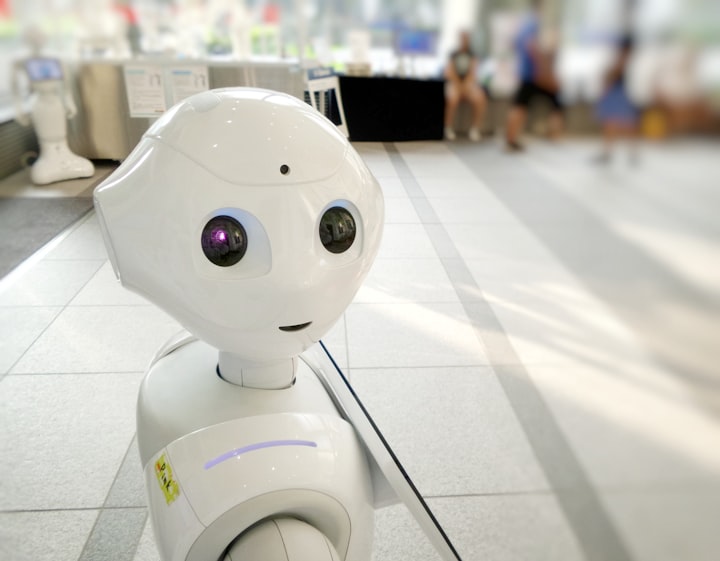Here is how MNCs are using Machine Learning to get ahead of their competition
We will go through some topmost machine learning case studies from world-class businesses to get an idea of how Amazon Web Services has been transforming institutions across industries in their computing needs and much more.

Overview
- Amazon Web Services (AWS), the cloud platform offered by Amazon.com Inc (AMZN), has become an essential component of the e-commerce giant's business portfolio.
- In this post we cover 10 Machine Learning case studies from world-class businesses that are using ML services from AWS to improve their business outcomes.
Introduction
When you look at an unmatched array of instances that you have in AWS coupled with the relentless innovation in chips, in the virtualisation layer and the compute platform, you are now getting reinvented instances every few months, instead of every few years, which is a big deal
-- Andy Jassy, CEO of Amazon
Since AWS’s cost is modified based on the customers’ usage, start-ups and small businesses can see the obvious benefits of using Amazon for their computing needs.
Hold tight as we're going to go through some topmost machine learning case studies from world-class businesses to get an idea of how Amazon Web Services has been transforming institutions across industries in their computing needs and much more.
Top 10 Machine Learning Case Studies:
1. BuildFax
About:
BuildFax started in 2008, today provides solutions tailored to professions like - insurance companies, building inspectors, and economic analysts, along with a variety of services, including indices that track trends like housing remodels and new commercial construction. The company is based in Asheville, N.C.
Challenge:
BuildFax provides estimates on the age and condition of roofs to help its customers, mainly insurance companies, establish policies and premiums. It needed a solution that was easier to use and would support faster, more accurate modeling for property-specific estimates.
Solution:
BulidFax uses Amazon Machine Learning to provide roof-age and job-cost estimations for insurers and builders, with property-specific values that don’t need to rely on broad, ZIP code-level estimates. It uses data sets from public sources and from customers to build models.

Impact:
- The best practices and ease of use built into Amazon Machine Learning dramatically streamline the process of building predictive models.
- Models that previously took six months or longer to create are now complete in four weeks or less.
For more details on BuildFax Case Study, visit the official website here.
2. Discovery
About:
Discovery Inc. is a multinational mass media television company based in New York City. Established in 1985, the company now operates many factual and lifestyle television brands, including the Discovery Channel, Food Network, HGTV, and TLC.
Challenge:
Viewers are watching more content than ever before. Their expectations for nearly endless content choices anytime, anywhere, and on any screen are driving business and operational changes for media companies. Discovery Inc. seized the chance to help its customers find curated content that matches their specific interests.
Solution:
Using AWS, Discovery Inc. (Discovery) built a streaming service, discovery+, using Amazon Personalize, a fully managed machine learning service that goes beyond rigid static rule-based recommendation systems and deploys custom machine learning models to deliver highly customized recommendations to customers.
Impact:
- On AWS, Discovery was able to achieve personalized content experiences for individual viewers.
- The company also now offers a flexible and scalable solution in discovery+ that works with its existing infrastructure.
For more details on Discovery Inc. Case Study, visit the official website here.
3. Madgex
About:
Madgex is a market-leading career technology provider. Their solutions boost engagement, provide insight and drive revenue for their customers. Operating in 14 countries, they manage more than 500 global brands, including Guardian Jobs and Gumtree Jobs.
Challenge:
Madgex sought to develop a tool using ML to augment and enrich job postings, giving them the ability to enhance their products and services. For example, to more accurately and efficiently match the right people to the right jobs or improve both candidate and client experiences.
Solution:
- Inawisdom’s Discovery as a Service (DaaS) method and AWS ML technologies expedited the project delivery and Proof of Value for Madgex. They applied advanced data science capabilities and techniques—combined with the power and scale of AWS SageMaker—to rapidly scale millions of input documents and generate domain-specific word embeddings for recruitment, delivering highly accurate outcomes.
- Inawisdom’s data scientists worked collaboratively with Madgex to define the problem, investigate the data—including unsupervised clustering—and then build and train a set of models to compare and contrast performance using different ML techniques.
Impact:
- Rapidly delivered highly accurate results in weeks with an advanced, cost-effective ML Proof of Value.
- Reduced millions of documents to essential information, delivering a high level of accuracy (88% and 89%).
For more details on the Madgex Case Study, visit the official website here.
4. University of Oxford’s Gardens, Libraries & Museums
About:
The University of Oxford’s Gardens, Libraries & Museums house some of the world’s most significant collections. They provide important places of scholarly inquiry and serve as the front door to the wealth of knowledge and research generated at Oxford, welcoming over 3 million visitors each year.
Challenge:
The University of Oxford houses 21 million objects in the collections of its Gardens, Libraries & Museums (GLAM)—artifacts and specimens that are among the world’s most significant. One aspect of GLAM’s mission is to preserve these assets and make them accessible to the world for education and research. However, the organization has only enough space to display about 10 percent of its holdings at a time, and there’s an enormous backlog of artifacts still waiting to be catalogued.
Solution:
- The Gardens and Museums IT team used Amazon SageMaker, a fully managed service that provides developers and data scientists with the ability to build, train, and deploy machine learning (ML) models quickly.
- Powered by Amazon Elastic Compute Cloud (Amazon EC2) instances, the models were trained and deployed at low cost to automatically catalogue the extensive coin collection of the Ashmolean Museum—which is the United Kingdom’s first public museum and the world’s first university museum.
Impact:
- Built and deployed 11 ML models in about 10 weeks
- Expects to save up to 3 years of work cataloguing a collection of 300,000 coins
- Cut inference time from minutes to seconds
For more details on the University of Oxford Case Study, visit the official website here.
5. Snoop
About:
Snoop is an innovative disruptor in the financial technology (FinTech) market, aiming to put billions of pounds back in consumers’ pockets. The app-based solution allows customers to control their finances quickly and easily from their mobile device while benefitting from highly personalized offers from merchants and service providers (i.e., utilities), including automated switching.
Challenge:
Snoop wanted to build a data-driven business, avoid expensive start-up costs, be cloud-native and build a platform that was robust and scalable. They wanted a data science and machine learning (ML) partner that could not only support them in creating their differentiated data and AI-driven business model, focused on hyper-personalization, but also provide continuous input into daily decisions and product development.
Solution:
- Inawisdom’s agile, iterative approach, pragmatic skills, and experience in integrating AWS services with its customer platforms fit well with Snoop’s way of working. Using AWS services, including Amazon Forecast and Personalize, enabled a quick start to help Snoop set up their first personalization model.
- Following a number of implementation sprints and the success of their collaborative working, Snoop and Inawisdom committed to a longer-term, more in-depth partnership. This meant Inawisdom could help them drive data analytics, provide extended services and incrementally support the hyper-personalization journey at each stage.
Impact:
- Within just six months, Snoop was able to create a sustainable data-driven business model that provided agile and flexible environments.
- The partnership allowed Snoop to de-risk their launch plans, increase knowledge of data science, ML and AWS within the team, and implement Phase 1 of the roadmap to support an initial minimum viable product (MVP) launch.
For more details on Snoop Case Study, visit the official website here.
6. Canopy
About:
Founded in 2013, Canopy is an asset aggregator platform for high-net-worth individuals. Canopy provides its clients with a single view of their financial holdings across asset classes and markets, by processing their financial statements and consolidating relevant information from them, in its platform’s customer interface. It counts Credit Suisse as a flagship client and investor.
Challenge:
For individuals with financial assets across multiple sources, maintaining a single, comprehensive view of their net worth can be time-consuming, as they will need to manually track and compile their financial holdings. This is a constant challenge for high-net-worth individuals, who tend to have a more diversified asset allocation. Founded in 2013 in Singapore, Canopy aims to resolve this issue.
Solution:
Amazon SageMaker enabled Canopy to efficiently develop its ML models and improve its OCR capabilities without having to invest in hiring more data engineers—the solution allows Canopy to consolidate the building, training, and deployment of ML models on one platform. SageMaker will update ML models automatically, whenever it discovers new information while parsing through financial records.
Impact:
- Able to digitize PDFs into APIs at scale
- Confidence in scaling to meet ten-fold user demand
- Ability to simultaneously train and deploy machine learning models under one platform
For more details on Canopy Case Study, visit the official website here.
7. Pomelo
About:
Launched in 2013, Pomelo Fashion is a global e-commerce service that sells clothes and accessories on its website, on Android and iOS apps, and in physical kiosks. Headquartered in Thailand, it has nearly two million customers in more than 50 countries.
Challenge:
Pomelo Fashion had been displaying items on its website in much the same way since it was founded in 2013. The setup had grown stale, not to mention that the algorithm for displaying the items relied on old data streams with limited inputs and spotty accuracy. So as a fast-growing, innovative startup, Pomelo Fashion set out to create personalized customer experiences that would improve the discoverability of new items and increase revenue—and it needed a solution that would do so at scale.
Solution:
- Pomelo Fashion turned to Amazon Web Services (AWS) and used Amazon Personalize, which enables developers to build applications with the same machine learning (ML) technology used by Amazon.com for real-time personalized recommendations.
- By using Amazon Personalize—and the services of AWS Advanced Technology Partners Segment and Braze—to build fresh sorting and categorizing features, Pomelo Fashion created a unique, personalized shopping experience that boosts customer engagement and more efficiently converts it into sales.
Impact:
- Increased gross revenue from category pages by up to 15%
- Boosted click-through rate from category to product pages by up to 18%
- Increased return on investment by 400% within 1 month
For more details on Pomelo Case Study, visit the official website here.
8. Portcast
About:
Portcast offers predictive visibility and demand forecasting technology for logistics companies and manufacturers. Its customers can reduce manual planning by up to 80 percent and more accurately determine cargo demand and arrival times to control costs.
Challenge:
Ocean freight shipping is the main mode of transport for global trade, accounting for 90 percent of trade volume. The ability to predict, and plan for, the arrival of goods at ports greatly determine supply chain efficiency, notwithstanding weather disruptions, customs delays, and other factors. Portcast wanted to reduce its customers’ manual effort and cost of container tracking by 80 percent and 20 percent respectively.
Solution:
-
Portcast uses Amazon SageMaker to speed up automation in its end-to-end ML cycle, from training to processing to predictions. By taking predictions out of the ML model as a separate service, Portcast is able to scale models independently and reduce memory requirements.
-
Previously, Portcast was limited by the number of processes it could run in parallel, as each model had to be loaded into memory. With all its models hosted on Amazon SageMaker, it can run hundreds of processes in parallel with no memory limit. Portcart have the potential to generate millions of predictions a day.
Impact:
- Saves at least 2–3 hours per week on infrastructure monitoring
- Scales from tracking hundreds to thousands of containers in 2 years
- Cuts ML deployment costs by at least 60%
- Promotes a self-service culture to solve internal bottlenecks
For more details on Portcast Case Study, visit the official website here.
9. G5
About:
G5, Inc. is a leading marketing optimization company for the real estate industry.
Through its Intelligent Marketing Cloud, G5 helps customers optimize advertising
and lead management to increase marketing efficiency and effectiveness.
G5 works with more than 7,000 properties in the United States and Canada.
Challenge:
G5 found that only 14% of its call leads were productive. While machine learning offered promise in addressing this inefficiency, the realities of implementation could prove to be time-consuming, expensive, and a barrier to innovation.
Solution:
Using H2O Driverless AI in conjunction with AWS, the company derived an accurate, relevant feature table from its data sets. Based on this matrix, the company can engineer a feature set around which it can build, test, tune, and deploy machine learning models. Results can then be scored to identify high-quality leads and improve sales conversions.

Impact:
- Lead scoring accuracy of over 95%.
- Leasing agents are connected with qualified leads 85% of the time.
- Feature engineering and model tuning time reduced by 80%.
- Cost savings: One G5 customer saved $500,000 annually.
For more details on G5, Inc. Case Study, visit the official website here.
10. Ringier Axel Springer Polska (RASP)
About:
Ringier Axel Springer Polska is a part of the European media group Ringier Axel Springer Media AG. It is one of the largest press publishers in Poland. In its portfolio, the company has over 170 titles and websites, amongst them Onet, Fakt, Forbes, and Newsweek Polska.
Challenge:
RASP is one of the largest media companies in Europe and publishes thousands of online articles daily. Unfortunately, however, their existing image search and upload tools were slowing down RASP Polska’s editorial process. They wanted to make it easier for their editors to publish online articles.
Solution:
To realize the project, the AWS Cloud and Amazon Rekognition were used, as the latter allows for accurate recognition of people in images, (including the number of people), as well as thousands of other objects and scenes, (such as telephones, bicycles, buildings, parking lots, and beaches). Amazon Rekognition also enables accurate face analysis and examines the attributes of people, providing detailed information about gender, age, emotions, etc. The prototype was also based on ML algorithms and, as such, can easily recognize logotypes and commercial signs of specific brands.
Impact:
- Accurately analyses detailed image attributes
- Easily manages Polish-language content
- Was realized in just 4 weeks
For more details on the RASP Case Study, visit the official website here.
Conclusion
The machine learning services are shaking up the computing world in the same way that Amazon is changing America’s retail space. By pricing its cloud products extremely cheaply, Amazon can provide affordable and scalable services to everyone from the newest start-up to a Fortune 500 company.
The world is changing with the power of relentless innovation. Let's be a part of this change by taking our first step in keeping ourselves informed and aware!
Stay tuned and have a nice day!



